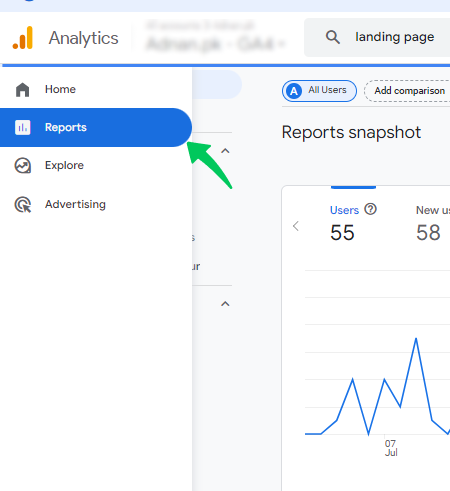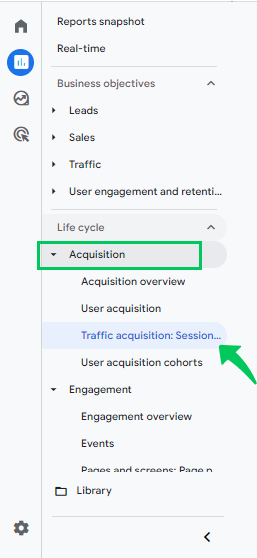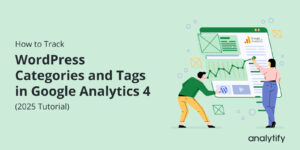
Google Analytics Organic Shopping (Explained 2025)
Curious how customers discover your products online? GA4 organic shopping data can reveal this and show you how to use it to boost your sales.
Analyzing GA4’s organic shopping data lets you see how users discover your products through search engines and optimize your website and marketing to attract more organic shoppers.
You’ll learn to track vital metrics, interpret key data points, and use these to enhance your online store’s performance, ensuring you stay ahead in today’s competitive digital marketplace.
Google Analytics Organic Shopping (TOC):
What is Organic Shopping in GA4?
In Google Analytics 4 (GA4), “Organic Shopping” typically refers to traffic that comes to your website from unpaid, organic search results when users are specifically searching for products or shopping-related content. This term is associated with users who find your website through a search engine (like Google) without clicking on paid advertisements and are likely to browse, research, or purchase products.
This report shows the traffic and conversions driven by unpaid links on shopping platforms like Google Shopping Feed, Amazon, eBay , etc.
Organic Shopping Traffic in GA4
Organic shopping traffic in GA4 helps users understand how to discover your products through organic shopping platforms. It Optimizes marketing strategies and resource allocation. There are two types of organic shopping traffic in GA4:
- Google Sources: Traffic from Google Shopping Free Listings on platforms like Shopping Tab, Google Search, Images, and YouTube. To identify this type of traffic, GA4’s Default Channel Grouping is set as “Organic Shopping.”
- Non-Google Sources: Traffic from other shopping platforms like Amazon, Alibaba, Shopify, or eBay identified by UTM parameters with utm_source as “SOURCE_CATEGORY_SHOPPING” or utm_campaign containing “shop” or “shopping.”
Why Track Organic Shopping Data in Google Analytics?
Tracking Organic Shopping in GA4 is crucial for businesses looking to optimize their online presence and enhance their e-commerce performance. Here are several reasons why tracking Organic Shopping in Google Analytics is essential:
- Measure Organic Search Effectiveness: It allows you to quantify the impact of your organic search optimization efforts. By understanding how many visitors are coming from search engines and converting them into customers, you can assess the effectiveness of your SEO strategies.
- Identify High-Performing Keywords: Organic shopping data helps you pinpoint the keywords driving the most traffic and conversions. This information can be used to optimize your content and meta descriptions to improve your search engine rankings.
- Understand Customer Behavior: By analyzing the actions of organic visitors, you can understand their preferences, interests, and the paths they take to make a purchase. This knowledge can help you tailor your website and marketing efforts to meet their needs better.
- Cost Efficiency: Organic traffic doesn’t require direct advertising, making it a cost-effective way to attract visitors. By tracking organic shopping, you can measure your SEO strategies’ return on investment (ROI) compared to paid campaigns.
- Optimize Website Performance: Organic shopping data can reveal areas where visitors drop off. By identifying these issues, you can improve your website’s design, navigation, and user experience to increase conversions.
- Improving Conversion Rates: Analyzing organic shopping data helps you identify which aspects of your site or product pages need optimization to improve conversion rates. For example, noticing high traffic but low conversions from organic shopping might indicate a need for better product descriptions, images, or checkout processes.
- Benchmark Performance: Tracking organic shopping allows you to compare your performance over time and against industry benchmarks. This can help you identify areas for improvement and set realistic goals for your SEO efforts.
By tracking organic shopping in Google Analytics, you can enhance your site’s performance, improve customer experience, and drive more sales through organic search channels.
Where to Find Organic Shopping Data in GA4?
In GA4, organic shopping data can be found by exploring the “Acquisition” reports, particularly under “Traffic Acquisition“ and “User Acquisition.” These reports provide knowledge about how users find your site, including details on organic traffic sources which we’ll show in the next section with detail. You can filter or segment the data by specific UTM parameters related to shopping campaigns, such as those tagged with utm_medium=organic or utm_campaign=shopping.
Additionally, you can create custom explorations or use Analytify’s Ecommerce reports to analyze the performance of organic shopping traffic, including metrics like transactions, revenue, and conversion rates.
Join 50,000+ beginners & professionals who use Analytify to simplify their Google Analytics!
How to Track Organic Shopping in GA4?
If you’re a WordPress user, Analytify is your ultimate tool for tracking eCommerce metrics, including organic shopping. Analytify offers a user-friendly interface and powerful features to help you optimize your online store’s performance. With Analytify, you can:
- Set Up eCommerce Tracking Effortlessly: Easily configure eCommerce tracking within your WordPress dashboard.
- Access Key Metrics at a Glance: View essential metrics like sales, revenue, conversion rates, and more directly from your WordPress admin.
- Gain Deeper Analysis: To understand your customers’ behavior, use advanced tracking features like form tracking, user journey reports, and campaign tracking.
Organic shopping traffic represents customers who found your products through unpaid search engine results, indicating strong purchase intent. But how do you track this valuable traffic in Analytify and utlize it to boost your sales?
Install Analytify and Enable Ecommerce Tracking
Install the powerful Analytify plugin on your WordPress website if you haven’t already done so. Its user-friendly interface makes setting up analytics with just a few clicks.
Within Analytify, activate the Ecommerce Tracking add-on. This will give you a detailed understanding of your online store’s performance.
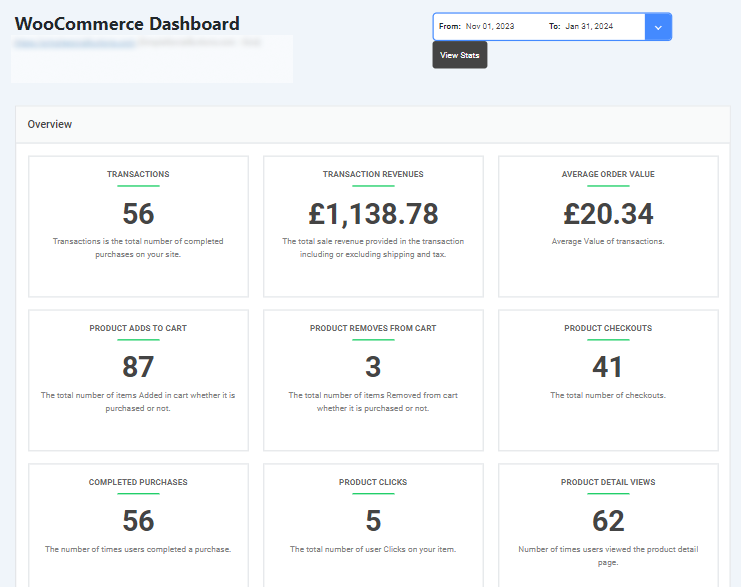
Tracking organic shopping in Google Analytics 4 (GA4) is essential for understanding how customers discover your products through search engines. You can optimize your website and marketing strategies by analyzing organic traffic data to attract more organic shoppers.
Here’s a step-by-step guide to track organic shopping in GA4:
Navigate to Reports
Click on the “Reports” tab in the GA4 interface.
Choose Traffic Acquisition
Choose the “Acquisition” tab. From the dropdown menu, select the “Traffic Acquisition” option.
Locate Organic Shopping
The “Traffic Acquisition” report lists “Session default channel groups.” One of these groups should be labeled “Organic Shopping.” This group will display data related to traffic that originated from unpaid or non-ad links on shopping sites, such as Google Shopping Free Listings.

Customize Organic Shopping Report
If you need more specific data, Include dimensions like “Session Source” and “Session Medium” to filter for organic shopping traffic. To gain more details about your organic shopping traffic in GA4, you can customize the reports to see which products get clicks from organic listings. Here’s how you can do it.
Add a Secondary Dimension:
- Click on the blue plus sign to add a secondary dimension to your report.
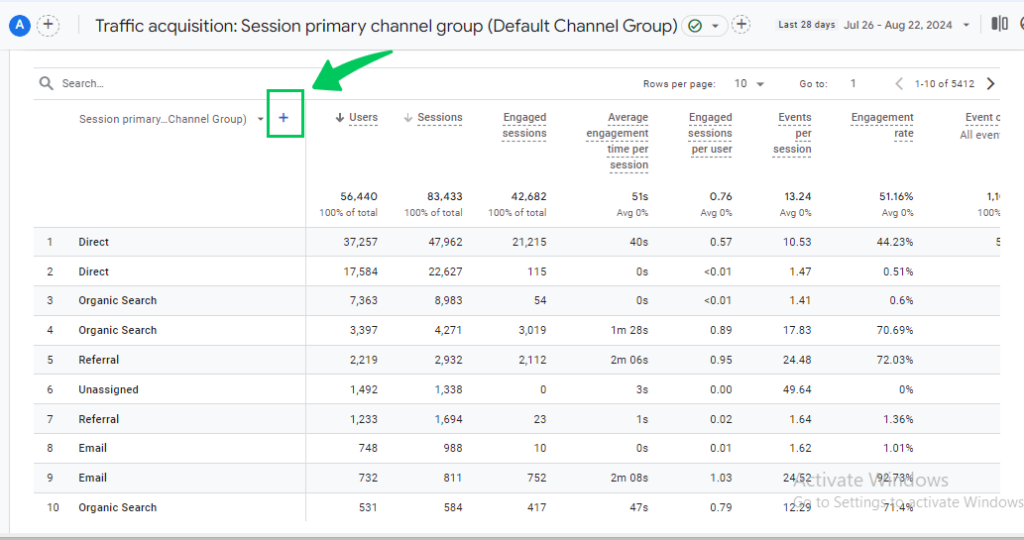
- Choose “Page/screen” and then “Landing page + query string.”
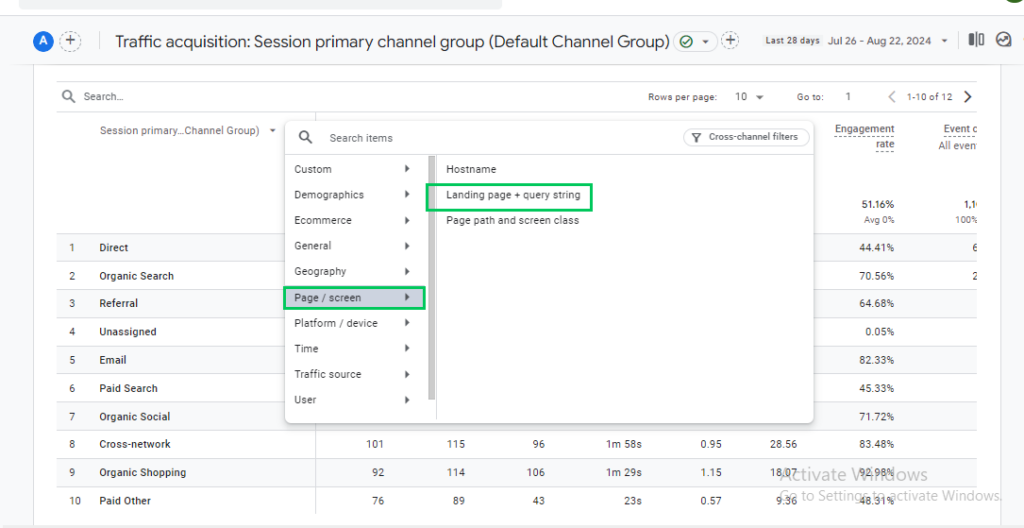
Filter Organic Shopping:
In the search bar, type “organic shopping” and hit enter. This will filter the data to show only the landing pages that received organic shopping traffic.
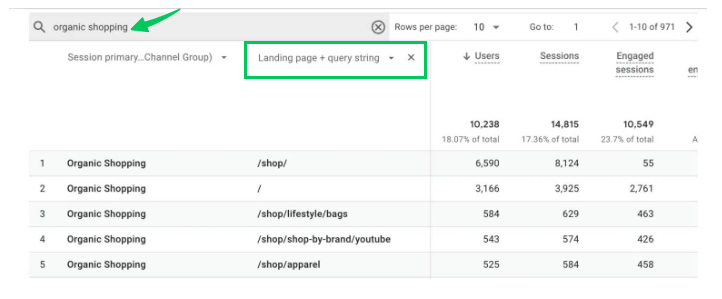
Following these steps, you can see which products or categories attract organic shopping traffic and whether these sessions lead to conversions.
This information is crucial for understanding which products perform well in organic shopping listings, how traffic flows to your site, and which pages contribute to sales and revenue. To better understand your traffic sources, setting up Channel Grouping in GA4 can help distinguish between organic, paid, and referral traffic.
Strategies to Boost Your Organic Shopping Traffic
Now that you’ve learned how to track organic shopping traffic, it’s time to take action and increase your organic visibility. Here are some proven strategies:
1. Optimize Product Content
- Keyword-rich Titles and Descriptions: Use relevant keywords throughout your product titles, descriptions, and meta tags.
- SEO Best Practices: Follow SEO guidelines to improve your product pages’ search engine rankings.
2. Maintain a High-Quality Product Feed
- Accuracy and Consistency: Ensure your product feed is accurate, up-to-date, and consistent with your website’s information.
- Automated Feeds: Consider using automated tools to streamline product feed updates.
3. Showcase High-Quality Images
- Visual Appeal: Use clear, attractive images that comply with shopping platform guidelines.
- Image Optimization: Optimize images for size and format to improve loading times and search engine visibility.
4. Implement Product Schema
- Rich Snippets: Use product schema to provide Google with detailed information about your products, such as ratings, pricing, and availability.
- Enhanced Visibility: Schema markup can improve your product’s visibility in search results and attract more clicks.
5. Regularly track and analyze your performance
Track your organic shopping performance regularly and adjust your strategies. Stay current with the latest SEO trends and best practices to maintain a competitive edge.
By following these tips and leveraging the power of organic shopping, you can drive more targeted traffic to your website, increase conversions, and boost your online sales.
GA4 Organic Shopping FAQs
1. How can I track Organic Shopping traffic in GA4?
To track organic shopping traffic in GA4, go to the “Acquisition” section and select “Traffic Acquisition.” You can then add a secondary dimension like “Landing page + query string” and filter the data by typing “organic shopping” in the search bar. This will allow you to analyze which pages and products receive traffic from organic shopping sources.
2. Can I compare Organic Shopping to Paid Shopping in Google Analytics?
Yes, Google Analytics shopping analytics allows you to compare Organic Shopping with Paid Shopping traffic. In the “Traffic Acquisition” report, you can analyze both channels to see how unpaid and paid shopping efforts differ in driving traffic, engagement, and conversions.
3. How is organic shopping traffic different from other traffic sources?
Organic shopping traffic is distinct from other sources because it originates from search engines and is not directly influenced by paid advertising. It indicates a strong purchase intent from users.
4. How can I track the effectiveness of my organic shopping optimization efforts?
Monitor the metrics mentioned earlier (organic sessions, conversions, revenue) over time to see if your optimizations yield positive results. Compare your performance to industry benchmarks to identify areas for improvement.
5. Can I track organic shopping from specific platforms (e.g., Google Shopping, Amazon)?
Using filters in GA4, you can track organic shopping from specific platforms. Look for dimensions like “Session Source” or “Session Medium” to identify traffic from shopping platforms.
Final Thoughts: Google Analytics Organic Shopping
In conclusion, mastering Google Analytics Organic Shopping is essential for any e-commerce business aiming to maximize the potential of its product listings. By effectively utilizing GA4 organic shopping reports, you can understand how your products perform across various shopping platforms without relying on paid ads.
Understanding and analyzing organic shopping traffic in GA4 allows you to refine your SEO and content strategies, driving more meaningful traffic and higher conversion rates.
While GA4 is powerful, it also has limitations. To gain a deeper understanding of user behavior and maximize conversions, consider using Analytify alongside GA4. Analytify offers advanced tracking beyond GA4’s defaults and its Ecommerce Tracking add-on, providing a detailed picture of user interactions. Combining GA4 organic shopping with this additional data empowers you to drive more sales.
For more comprehensive understanding of organic search in Google Analytics, visit this detailed article: How to Analyze Organic Search in Google Analytics 4.
What are your thoughts on using GA4 Organic Shopping for your e-commerce business? Share your experiences and questions in the comments below!

